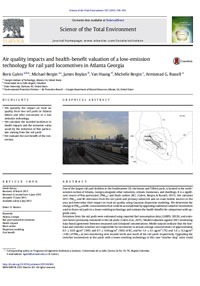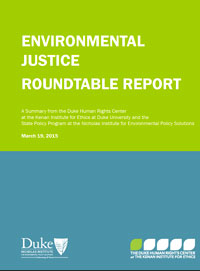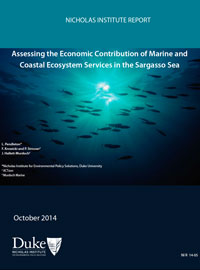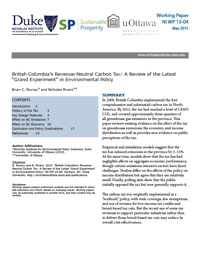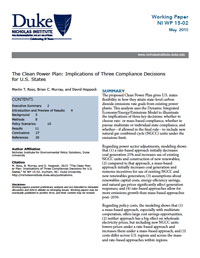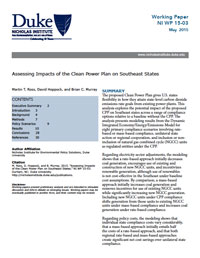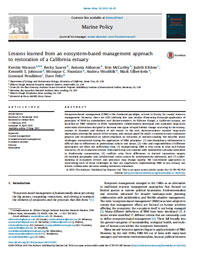Publications
Air Quality Impacts and Health-Benefit Valuation of a Low-Emission Technology for Rail Yard Locomotives in Atlanta, Georgia
One of the largest railyard facilities in the southeastern United States is located in the densely populated northwestern section of Atlanta, Georgia, near other industries, schools, and dwellings. It is a significant source of fine particulates (PM2.5) and black carbon (BC). This article in Science of the Total Environment calculates 2011 PM2.5 and BC emissions from the yard and from primary industrial and on-road mobile sources in the area and determines their impact on local air quality using Gaussian dispersion modeling. It also determines the change in PM2.5 and BC concentrations that could be accomplished by transitioning the yard's traditional switcher locomotives to lower-emitting technology. The study finds that the potential reduction in these concentrations facilitates attainment of the PM2.5 National Ambient Air Quality Standards in the area and that, based on Environmental Benefits Mapping and Analysis Program (BenMAP) modeling, resulting health benefits would surpass conversion costs by approximately 140 million dollars over 10 years.
Environmental Justice Roundtable Report
This report from the Nicholas Institute for Environmental Policy Solutions and the Kenan Institute for Ethics summarizes discussion from a roundtable with experts from Duke University, the University of North Carolina at Chapel Hill, and North Carolina State University and Research Triangle Institute that explored the multiple starting points for environmental justice research in the Triangle area.
The Environmental and Economic Effects of Regional Bioenergy Policy in the Southeastern U.S.
The unique generation, landownership, and resource attributes of the southeastern United States make the region an important test bed for implementation of novel renewable energy policy interventions. This study evaluates the environmental and economic implications of one such intervention, a hypothetical region-wide renewable portfolio standard (RPS) with biomass carve-outs. It utilizes the Forest and Agriculture Sector Optimization Model with Greenhouse Gases (FASOMGHG) to assess the multi-sector and interregional allocation of forest harvest activity, and then uses the Sub-Regional Timber Supply (SRTS) model to assess intraregional variation in forest composition and greenhouse gas (GHG) mitigation potential. The analysis finds that existing resource conditions influence the regional distribution of land use and harvest changes, resulting in a spatially and temporally diverse forest carbon response. Net forest carbon in the Southeast is greater in the RPS Scenario than in the No RPS Scenario in all but the final years of the model run. Accounting for displaced fossil emissions yields net GHG reductions in all time periods. Both research methodology and findings are also applicable to a broader suite of domestic and international policies, including European Union renewable energy initiatives and GHG mitigation under Section 111 of the U.S. Clean Air Act.
Assessing the Economic Contribution of Marine and Coastal Ecosystem Services in the Sargasso Sea
This report, which was revised April 2015, provides a variety of measures of the Sargasso Sea’s economic value and impact, especially net and gross revenues associated with ecosystem services supported by the sea. It captures just a small portion of these services and does not reflect their complete and total net value. Yet analysis of data on even this small portion suggests that the economic importance of the Sargasso Sea is significant. Economic expenditures and revenues directly or potentially linked to that sea range from tens to hundreds of million of dollars a year.
Sustainability Guidelines and Forest market Response: An Assessment of European Union Pellet Demand in the Southeastern United States
Woody biomass from the southeast United States is expected to play an important role in meeting European Union (EU) renewable energy targets. In crafting policies to guide bioenergy development and in guiding investment decisions to meet established policy goals, a firm understanding of the interaction between policy targets and forest biomass markets is necessary, as is the effect that this interaction will have on environmental and economic objectives. This analysis, featured in the journal Global Change Biology-Bioenergy, increases understanding of these interactions by modeling the response of southern U.S. forest markets to new pellet demand in the presence of sustainability sourcing or harvest criteria. Based on modeled scenarios, it finds that wood pellets from the Southeast United States could be used to meet sustainability guidelines set by the EU to achieve its larger renewable energy and greenhouse gas emissions goals.
British Columbia’s Revenue-Neutral Carbon Tax: A Review of the Latest “Grand Experiment” in Environmental Policy
In 2008, British Columbia implemented the first comprehensive and substantial carbon tax in North America. By 2012, the tax had reached a level of C$30/t CO2, and covered approximately three-quarters of all greenhouse gas emissions in the province. This paper reviews existing evidence on the effect of the tax on greenhouse emissions, the economy, and income distribution as well as provides new evidence on public perceptions of the tax. Empirical and simulation models suggest that the tax has reduced emissions in the province by 5–15%. At the same time, models show that the tax has had negligible effects on aggregate economic performance, though certain emissions-intensive sectors have faced challenges. Studies differ on the effects of the policy on income distribution but agree that they are relatively small. Finally, polling data show that the public initially opposed the tax but now generally supports it. The carbon tax was originally implemented as a “textbook” policy, with wide coverage, few exemptions, and use of revenue for low-income tax credits and broad-based tax cuts. But the recent use of some tax revenues to support particular industries rather than to deliver those broad-based tax cuts may reduce its overall cost-effectiveness.
This paper was subsequently published in the journal Energy Policy.
The Clean Power Plan: Implications of Three Compliance Decisions for U.S. States
The proposed Clean Power Plan gives U.S. states flexibility in how they attain state-level carbon dioxide emissions rate goals from existing power plants. This analysis uses the Dynamic Integrated Economy/Energy/Emissions Model to illuminate the implications of three key decisions: whether to choose rate- or mass-based compliance, whether to pursue multistate or individual state compliance, and whether—if allowed in the final rule—to include new natural gas combined cycle (NGCC) units under the emissions limit.
Regarding power sector adjustments, modeling shows that (1) a rate-based approach initially decreases coal generation 25% and increases use of existing NGCC units and construction of new renewables; (2) compared to that approach, a mass-based approach initially increases coal generation and removes incentives for use of existing NGCC and new renewables generation; (3) assumptions about renewables capital costs, energy efficiency savings, and natural gas prices significantly affect generation responses; and (4) rate-based approaches allow for more emissions growth than mass-based approaches post–2030.
Regarding policy costs, the modeling shows that (1) a mass-based approach, especially with multistate cooperation, offers large cost savings opportunities; (2) neither approach has a big effect on wholesale electricity prices, but including new NGCC units lowers prices under a rate-based approach and increases them under a mass-based approach; and (3) costs differ across U.S. regions and across the mass- and rate-based approaches within regions.
Assessing Impacts of the Clean Power Plan on Southeast States
The proposed Clean Power Plan gives U.S. states flexibility in how they attain state-level carbon dioxide emissions rate goals from existing power plants. This analysis explores the potential impact of the proposed CPP on Southeast states across a range of compliance options relative to a baseline without the CPP. The analysis presents modeling results from the Dynamic Integrated Economy/Energy/Emissions Model for eight primary compliance scenarios involving rate-based or mass-based compliance, unilateral state action or regional cooperation, and inclusion or non-inclusion of natural gas combined cycle (NGCC) units as regulated entities under the CPP.
Regarding electricity sector adjustments, the modeling shows that a rate-based approach initially decreases coal generation, encourages use of existing and construction of new NGCC units, and incentivizes renewable generation, although use of renewables is not cost-effective in the Southeast under baseline cost assumptions. By comparison, a mass-based approach initially increases coal generation and removes incentives for use of existing NGCC units while significantly increasing new NGCC generation. Including new NGCC units under CPP compliance shifts generation from those units to existing NGCC units under mass-based compliance and increases coal generation under rate-based compliance.
Regarding policy costs, the modeling shows that individual state compliance costs vary considerably, that a mass-based approach initially entails half the costs of a rate-based approach, and that both regional rate-based and mass-based approaches create significant net cost savings over unilateral state compliance.
Lessons Learned from an Ecosystem-Based Management Approach to Restoration of a California Estuary
Ecosystem-based management (EBM) is the dominant paradigm, at least in theory, for coastal resource management. However, there are still relatively few case studies illustrating thorough application of principles of EBM by stakeholders and decision makers. This Marine Policy article details work done at Elkhorn Slough, a California estuary. There, stakeholders collaboratively developed and evaluated large-scale restoration alternatives designed to decrease two types of rapid habitat change occurring in the estuary, erosion of channels and dieback of salt marsh. In the end, decision makers rejected large-scale alternatives altering the mouth of the estuary, and instead opted for small- to medium-scale restoration projects and recommended an added emphasis on reduction of nutrient-loading. The article describes seven challenges encountered during the application of EBM principles.
Evaluating the Basic Elements of Transparency of Regional Fisheries Management Organizations
A new study in the journal Marine Policy examines, for the first time, the transparency of international fisheries management organisations operating on the high seas. Transparency is broadly recognized as an essential component of sustainable development and good governance, especially with regard to the management of natural resources. In order to develop a more secure investment environment and provide the public with knowledge of natural resource rents received by their governments, terrestrially-based standards such as the Extractive Industries Transparency Initiative have been established to ensure greater fiscal transparency. The results that emerged from the study are mixed, highlighting a number of good and also weak practices.

